Mary Anne Yarde's Blog: The Coffee Pot Book Club , page 217
October 5, 2016
Author’s Inspiration ~ Corinda Pitts Marsh #histfic @CorindaMarsh
Please give a warm welcome to historical fiction author, Corinda Pitts Marsh. Corinda is going to share with us her inspiration behind her book… Behind the Tupelo Tree
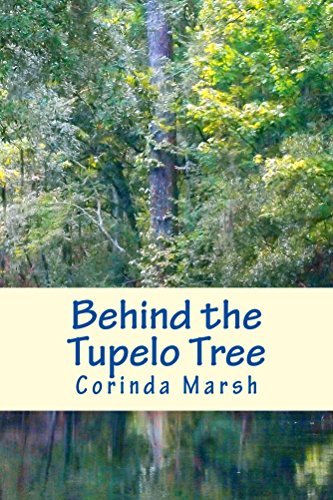 Two strong Southern women, one a slave and the other a slave owner, forge a family dynasty with the men they love. These women must brave turbulent times and decide right and wrong in a hostile world too often based on color and gender. They from an alliance that lasts for generations. Pivotal in the lives of these women, big Earl loves and protects them, risking his own life. Coming to them from the block in New Orleans with heavy iron chains on his ankles, Earl changes their lives forever. Later he does the same for a third woman from another world. His legacy carries him into the next century as his son stands behind the Tupelo tree watching helplessly as an innocent man is lynched. The intertwining of these lives tells the story Behind the Tupelo Tree. This edition includes the stories of A Civil War and The Ghost of Blackwater Creekas well as the story of Yemaya, the mother of the Ghost. The stories take the reader from the Antebellum South through the Civil War and the troubled times of the early 20th century.
Two strong Southern women, one a slave and the other a slave owner, forge a family dynasty with the men they love. These women must brave turbulent times and decide right and wrong in a hostile world too often based on color and gender. They from an alliance that lasts for generations. Pivotal in the lives of these women, big Earl loves and protects them, risking his own life. Coming to them from the block in New Orleans with heavy iron chains on his ankles, Earl changes their lives forever. Later he does the same for a third woman from another world. His legacy carries him into the next century as his son stands behind the Tupelo tree watching helplessly as an innocent man is lynched. The intertwining of these lives tells the story Behind the Tupelo Tree. This edition includes the stories of A Civil War and The Ghost of Blackwater Creekas well as the story of Yemaya, the mother of the Ghost. The stories take the reader from the Antebellum South through the Civil War and the troubled times of the early 20th century.
***
 Selma, Alabama, is the site of one of the most publicized Civil Rights demonstrations of the 1960’s. For some white Southerners, it represents a memory they wish to forget. For many black Southerners, it represents a time of horror that led to freedom, freedom to use restrooms formerly reserved for whites, freedom to drink from a water fountain in a city park, freedom to sit in any vacant seat on a bus or at a lunch counter when they are hungry. Selma, however, is rooted much deeper in history than many Americans realize. It was the first capital of Alabama, and it was the site of a critical and final battle in the American Civil War. Selma’s foundries made most of the Confederacy’s munitions and built some of the ships used in naval battles. Selma was also the site of Castle Morgan, a prison housing captured Union soldiers between 1863 and 1865. Prisoners who survived its horrors of overcrowding and flooding were released at the end of the war and loaded onto the steamboat Sultana to return to their homes. Unfortunately, one of the boilers on the Sultanaexploded, killing 1800 of the 2400 men aboard shortly before they reached Memphis, Tennessee.I knew nothing about the Sultana or the Civil War battle at Selma, nor was I familiar with the horrors of Castle Morgan. These and so many other facts are Secrets of the South. They became my novel, Behind the Tupelo Tree, but they didn’t come to me on their own. The ideas came from Olafur Gunnarsson, my friend and mentor for the past twenty years. He is an Icelandic author, who reveres history. When I was struggling for inspiration, he said, “Look for a historical event that interests you and put yourself into a character totally different from yourself, preferably a male character of a different heritage, then write, write, and write.” Hands down, the best advice I ever received. From those words, the Secrets of the South stories were born. Inspiration is often as close as a good friend. After that conversation, I researched Civil War battles. The closest one to my home occurred in Selma. When I began to dig, secrets crawled out of their crevices. The first capital of Alabama was eight miles outside Selma in a settlement called Cahawba. Fortunately, Cahawba is only a four-hour drive from my home, so my husband and I visited the Old Cahawba Archaeological Park (www.cahawba.com). We walked among the ruins and stood beside the fireplace in the prison enclosure. Although the prison was known as Castle Morgan, it was anything but a castle. It was a 15,000 square foot cotton warehouse hastily converted in 1863 into a prison with 432 bed spaces. By March 1865, one month before the war ended, more than 3,000 men were incarcerated within its walls. That is five square feet for each man—less space than it takes for one man to lie down. In February 1865, the town experienced a devastating flood. It was bitterly cold, and the men were standing waist deep in muddy contaminated water, so prison officials allowed some of the men to leave the compound to search for logs or other objects they could stand on to get them out of the water. Miraculously, the death rate at Castle Morgan was only two percent, the lowest of any Civil War prison. This was mainly due to the kindness of one of the two men in charge of the prison, H. A. M. Henderson, a Methodist minister. Of course, one of the good guys in my novel winds up in this prison.Research uncovered bits and pieces of history that kept me busy for the three years it took to write the novel. No Civil War novel would be complete without comments about Jefferson Davis, the President of the Confederacy, and Robert E. Lee, its most famous general. Davis and some of his friends got into a bit of mischief at West Point Military Academy. During Christmas break, Davis and his buddies left campus to reconnoiter a stash of eggnog, a Southern Christmas drink containing varying amounts of alcohol. The young men proceeded to get thoroughly inebriated. Jefferson Davis was one of the revelers who got caught, and the self-righteous Robert E. Lee ratted on his comrades. Davis was never one to shrink from a challenge. While serving in the U.S. Cavalry under the future president of the United States, Zachery Taylor, he fell in love with Taylor’s daughter. However, Taylor refused to allow Davis to marry his daughter, so Davis resigned from the Cavalry and married her anyway. The couple went to Louisiana on their honeymoon where both of them contracted malaria. Davis survived but the love of his life did not. They had been married only three months when she died. Davis went back to his farm in Mississippi where he remained in seclusion for several years. When he returned to the Cavalry, he served admirably causing Taylor to comment that apparently his daughter was a better judge of character than he. Tupelo Treecarries two families, one of slaves and the other their owners, through the war and into post-war conflicts and adjustments. After the war, the story moves from Castle Morgan and Cahawba to Campbelton, Florida. The inspiration for this part of the story came from a random comment my husband made about a lynching that occurred sixty miles from our home in 1934. My husband’s employer had seen the lynching when he was a child. What I found out about that lynching was the most horrific thing I had ever read. Claude Neal was lynched in Marianna, Florida, in 1934. He was accused of rape, but no significant evidence was ever found: he was dead before evidence could be investigated. The details of this lynching became a chapter in my story. These facts disgust some readers, but others see the reason for their inclusion. Only when we know our history do we have any chance to make our world better.When I realized the impact my story was having on readers, I understood why I write. I used to tell my students I had only two goals for each literature class: 1) The class should teach you how to live your life better, and 2) it should make you want to read more good literature. Now I try to do that through my books. Olafur Gunnarsson and my husband gave me the inspiration for my writing, but it is my readers who keep me writing. Inspiration is all around us. We only have to open our eyes and ears to see and hear inspiration for our stories.
Selma, Alabama, is the site of one of the most publicized Civil Rights demonstrations of the 1960’s. For some white Southerners, it represents a memory they wish to forget. For many black Southerners, it represents a time of horror that led to freedom, freedom to use restrooms formerly reserved for whites, freedom to drink from a water fountain in a city park, freedom to sit in any vacant seat on a bus or at a lunch counter when they are hungry. Selma, however, is rooted much deeper in history than many Americans realize. It was the first capital of Alabama, and it was the site of a critical and final battle in the American Civil War. Selma’s foundries made most of the Confederacy’s munitions and built some of the ships used in naval battles. Selma was also the site of Castle Morgan, a prison housing captured Union soldiers between 1863 and 1865. Prisoners who survived its horrors of overcrowding and flooding were released at the end of the war and loaded onto the steamboat Sultana to return to their homes. Unfortunately, one of the boilers on the Sultanaexploded, killing 1800 of the 2400 men aboard shortly before they reached Memphis, Tennessee.I knew nothing about the Sultana or the Civil War battle at Selma, nor was I familiar with the horrors of Castle Morgan. These and so many other facts are Secrets of the South. They became my novel, Behind the Tupelo Tree, but they didn’t come to me on their own. The ideas came from Olafur Gunnarsson, my friend and mentor for the past twenty years. He is an Icelandic author, who reveres history. When I was struggling for inspiration, he said, “Look for a historical event that interests you and put yourself into a character totally different from yourself, preferably a male character of a different heritage, then write, write, and write.” Hands down, the best advice I ever received. From those words, the Secrets of the South stories were born. Inspiration is often as close as a good friend. After that conversation, I researched Civil War battles. The closest one to my home occurred in Selma. When I began to dig, secrets crawled out of their crevices. The first capital of Alabama was eight miles outside Selma in a settlement called Cahawba. Fortunately, Cahawba is only a four-hour drive from my home, so my husband and I visited the Old Cahawba Archaeological Park (www.cahawba.com). We walked among the ruins and stood beside the fireplace in the prison enclosure. Although the prison was known as Castle Morgan, it was anything but a castle. It was a 15,000 square foot cotton warehouse hastily converted in 1863 into a prison with 432 bed spaces. By March 1865, one month before the war ended, more than 3,000 men were incarcerated within its walls. That is five square feet for each man—less space than it takes for one man to lie down. In February 1865, the town experienced a devastating flood. It was bitterly cold, and the men were standing waist deep in muddy contaminated water, so prison officials allowed some of the men to leave the compound to search for logs or other objects they could stand on to get them out of the water. Miraculously, the death rate at Castle Morgan was only two percent, the lowest of any Civil War prison. This was mainly due to the kindness of one of the two men in charge of the prison, H. A. M. Henderson, a Methodist minister. Of course, one of the good guys in my novel winds up in this prison.Research uncovered bits and pieces of history that kept me busy for the three years it took to write the novel. No Civil War novel would be complete without comments about Jefferson Davis, the President of the Confederacy, and Robert E. Lee, its most famous general. Davis and some of his friends got into a bit of mischief at West Point Military Academy. During Christmas break, Davis and his buddies left campus to reconnoiter a stash of eggnog, a Southern Christmas drink containing varying amounts of alcohol. The young men proceeded to get thoroughly inebriated. Jefferson Davis was one of the revelers who got caught, and the self-righteous Robert E. Lee ratted on his comrades. Davis was never one to shrink from a challenge. While serving in the U.S. Cavalry under the future president of the United States, Zachery Taylor, he fell in love with Taylor’s daughter. However, Taylor refused to allow Davis to marry his daughter, so Davis resigned from the Cavalry and married her anyway. The couple went to Louisiana on their honeymoon where both of them contracted malaria. Davis survived but the love of his life did not. They had been married only three months when she died. Davis went back to his farm in Mississippi where he remained in seclusion for several years. When he returned to the Cavalry, he served admirably causing Taylor to comment that apparently his daughter was a better judge of character than he. Tupelo Treecarries two families, one of slaves and the other their owners, through the war and into post-war conflicts and adjustments. After the war, the story moves from Castle Morgan and Cahawba to Campbelton, Florida. The inspiration for this part of the story came from a random comment my husband made about a lynching that occurred sixty miles from our home in 1934. My husband’s employer had seen the lynching when he was a child. What I found out about that lynching was the most horrific thing I had ever read. Claude Neal was lynched in Marianna, Florida, in 1934. He was accused of rape, but no significant evidence was ever found: he was dead before evidence could be investigated. The details of this lynching became a chapter in my story. These facts disgust some readers, but others see the reason for their inclusion. Only when we know our history do we have any chance to make our world better.When I realized the impact my story was having on readers, I understood why I write. I used to tell my students I had only two goals for each literature class: 1) The class should teach you how to live your life better, and 2) it should make you want to read more good literature. Now I try to do that through my books. Olafur Gunnarsson and my husband gave me the inspiration for my writing, but it is my readers who keep me writing. Inspiration is all around us. We only have to open our eyes and ears to see and hear inspiration for our stories.
Links for PurchaseAmazon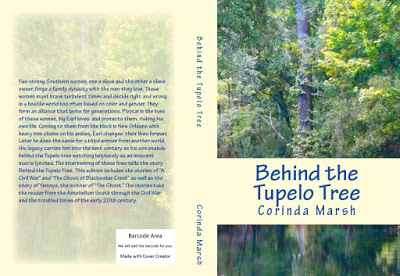
About the author
I am first a grandmother then a Southern writer, raised and steeped in the traditions of the deep South. I returned to college at the age of 44, a challenge which certainly changed my life. I fell in love with words and will never recover from that addiction. My favorite authors are Thomas Wolfe, Ernest Hemingway, Albert Camus, and Friedrich Nietzsche. I enjoy study of the paranormal and deep human emotions. Writing for me is a way of knowing. My doctorate is in 20th Century American Literature, but my interests range far and wide. Taking the lead from T.S. Eliot, I steal from those who have come before. Plato and Milton as well as many others are often my literary playmates. I had an imaginary friend when I was four years old, so perhaps I never recovered. I once heard a professor say that for every book one writes, he or she must read 1000 others. This holds true for me. The writers we study become a part of who we are if we are paying attention, and I hope my antennas are tuned to the proper channels. When I’m not reading or writing, I enjoy growing orchids, watching birds, and cooking for my family.Useful LinksTwitter Facebook
 Two strong Southern women, one a slave and the other a slave owner, forge a family dynasty with the men they love. These women must brave turbulent times and decide right and wrong in a hostile world too often based on color and gender. They from an alliance that lasts for generations. Pivotal in the lives of these women, big Earl loves and protects them, risking his own life. Coming to them from the block in New Orleans with heavy iron chains on his ankles, Earl changes their lives forever. Later he does the same for a third woman from another world. His legacy carries him into the next century as his son stands behind the Tupelo tree watching helplessly as an innocent man is lynched. The intertwining of these lives tells the story Behind the Tupelo Tree. This edition includes the stories of A Civil War and The Ghost of Blackwater Creekas well as the story of Yemaya, the mother of the Ghost. The stories take the reader from the Antebellum South through the Civil War and the troubled times of the early 20th century.
Two strong Southern women, one a slave and the other a slave owner, forge a family dynasty with the men they love. These women must brave turbulent times and decide right and wrong in a hostile world too often based on color and gender. They from an alliance that lasts for generations. Pivotal in the lives of these women, big Earl loves and protects them, risking his own life. Coming to them from the block in New Orleans with heavy iron chains on his ankles, Earl changes their lives forever. Later he does the same for a third woman from another world. His legacy carries him into the next century as his son stands behind the Tupelo tree watching helplessly as an innocent man is lynched. The intertwining of these lives tells the story Behind the Tupelo Tree. This edition includes the stories of A Civil War and The Ghost of Blackwater Creekas well as the story of Yemaya, the mother of the Ghost. The stories take the reader from the Antebellum South through the Civil War and the troubled times of the early 20th century.***
 Selma, Alabama, is the site of one of the most publicized Civil Rights demonstrations of the 1960’s. For some white Southerners, it represents a memory they wish to forget. For many black Southerners, it represents a time of horror that led to freedom, freedom to use restrooms formerly reserved for whites, freedom to drink from a water fountain in a city park, freedom to sit in any vacant seat on a bus or at a lunch counter when they are hungry. Selma, however, is rooted much deeper in history than many Americans realize. It was the first capital of Alabama, and it was the site of a critical and final battle in the American Civil War. Selma’s foundries made most of the Confederacy’s munitions and built some of the ships used in naval battles. Selma was also the site of Castle Morgan, a prison housing captured Union soldiers between 1863 and 1865. Prisoners who survived its horrors of overcrowding and flooding were released at the end of the war and loaded onto the steamboat Sultana to return to their homes. Unfortunately, one of the boilers on the Sultanaexploded, killing 1800 of the 2400 men aboard shortly before they reached Memphis, Tennessee.I knew nothing about the Sultana or the Civil War battle at Selma, nor was I familiar with the horrors of Castle Morgan. These and so many other facts are Secrets of the South. They became my novel, Behind the Tupelo Tree, but they didn’t come to me on their own. The ideas came from Olafur Gunnarsson, my friend and mentor for the past twenty years. He is an Icelandic author, who reveres history. When I was struggling for inspiration, he said, “Look for a historical event that interests you and put yourself into a character totally different from yourself, preferably a male character of a different heritage, then write, write, and write.” Hands down, the best advice I ever received. From those words, the Secrets of the South stories were born. Inspiration is often as close as a good friend. After that conversation, I researched Civil War battles. The closest one to my home occurred in Selma. When I began to dig, secrets crawled out of their crevices. The first capital of Alabama was eight miles outside Selma in a settlement called Cahawba. Fortunately, Cahawba is only a four-hour drive from my home, so my husband and I visited the Old Cahawba Archaeological Park (www.cahawba.com). We walked among the ruins and stood beside the fireplace in the prison enclosure. Although the prison was known as Castle Morgan, it was anything but a castle. It was a 15,000 square foot cotton warehouse hastily converted in 1863 into a prison with 432 bed spaces. By March 1865, one month before the war ended, more than 3,000 men were incarcerated within its walls. That is five square feet for each man—less space than it takes for one man to lie down. In February 1865, the town experienced a devastating flood. It was bitterly cold, and the men were standing waist deep in muddy contaminated water, so prison officials allowed some of the men to leave the compound to search for logs or other objects they could stand on to get them out of the water. Miraculously, the death rate at Castle Morgan was only two percent, the lowest of any Civil War prison. This was mainly due to the kindness of one of the two men in charge of the prison, H. A. M. Henderson, a Methodist minister. Of course, one of the good guys in my novel winds up in this prison.Research uncovered bits and pieces of history that kept me busy for the three years it took to write the novel. No Civil War novel would be complete without comments about Jefferson Davis, the President of the Confederacy, and Robert E. Lee, its most famous general. Davis and some of his friends got into a bit of mischief at West Point Military Academy. During Christmas break, Davis and his buddies left campus to reconnoiter a stash of eggnog, a Southern Christmas drink containing varying amounts of alcohol. The young men proceeded to get thoroughly inebriated. Jefferson Davis was one of the revelers who got caught, and the self-righteous Robert E. Lee ratted on his comrades. Davis was never one to shrink from a challenge. While serving in the U.S. Cavalry under the future president of the United States, Zachery Taylor, he fell in love with Taylor’s daughter. However, Taylor refused to allow Davis to marry his daughter, so Davis resigned from the Cavalry and married her anyway. The couple went to Louisiana on their honeymoon where both of them contracted malaria. Davis survived but the love of his life did not. They had been married only three months when she died. Davis went back to his farm in Mississippi where he remained in seclusion for several years. When he returned to the Cavalry, he served admirably causing Taylor to comment that apparently his daughter was a better judge of character than he. Tupelo Treecarries two families, one of slaves and the other their owners, through the war and into post-war conflicts and adjustments. After the war, the story moves from Castle Morgan and Cahawba to Campbelton, Florida. The inspiration for this part of the story came from a random comment my husband made about a lynching that occurred sixty miles from our home in 1934. My husband’s employer had seen the lynching when he was a child. What I found out about that lynching was the most horrific thing I had ever read. Claude Neal was lynched in Marianna, Florida, in 1934. He was accused of rape, but no significant evidence was ever found: he was dead before evidence could be investigated. The details of this lynching became a chapter in my story. These facts disgust some readers, but others see the reason for their inclusion. Only when we know our history do we have any chance to make our world better.When I realized the impact my story was having on readers, I understood why I write. I used to tell my students I had only two goals for each literature class: 1) The class should teach you how to live your life better, and 2) it should make you want to read more good literature. Now I try to do that through my books. Olafur Gunnarsson and my husband gave me the inspiration for my writing, but it is my readers who keep me writing. Inspiration is all around us. We only have to open our eyes and ears to see and hear inspiration for our stories.
Selma, Alabama, is the site of one of the most publicized Civil Rights demonstrations of the 1960’s. For some white Southerners, it represents a memory they wish to forget. For many black Southerners, it represents a time of horror that led to freedom, freedom to use restrooms formerly reserved for whites, freedom to drink from a water fountain in a city park, freedom to sit in any vacant seat on a bus or at a lunch counter when they are hungry. Selma, however, is rooted much deeper in history than many Americans realize. It was the first capital of Alabama, and it was the site of a critical and final battle in the American Civil War. Selma’s foundries made most of the Confederacy’s munitions and built some of the ships used in naval battles. Selma was also the site of Castle Morgan, a prison housing captured Union soldiers between 1863 and 1865. Prisoners who survived its horrors of overcrowding and flooding were released at the end of the war and loaded onto the steamboat Sultana to return to their homes. Unfortunately, one of the boilers on the Sultanaexploded, killing 1800 of the 2400 men aboard shortly before they reached Memphis, Tennessee.I knew nothing about the Sultana or the Civil War battle at Selma, nor was I familiar with the horrors of Castle Morgan. These and so many other facts are Secrets of the South. They became my novel, Behind the Tupelo Tree, but they didn’t come to me on their own. The ideas came from Olafur Gunnarsson, my friend and mentor for the past twenty years. He is an Icelandic author, who reveres history. When I was struggling for inspiration, he said, “Look for a historical event that interests you and put yourself into a character totally different from yourself, preferably a male character of a different heritage, then write, write, and write.” Hands down, the best advice I ever received. From those words, the Secrets of the South stories were born. Inspiration is often as close as a good friend. After that conversation, I researched Civil War battles. The closest one to my home occurred in Selma. When I began to dig, secrets crawled out of their crevices. The first capital of Alabama was eight miles outside Selma in a settlement called Cahawba. Fortunately, Cahawba is only a four-hour drive from my home, so my husband and I visited the Old Cahawba Archaeological Park (www.cahawba.com). We walked among the ruins and stood beside the fireplace in the prison enclosure. Although the prison was known as Castle Morgan, it was anything but a castle. It was a 15,000 square foot cotton warehouse hastily converted in 1863 into a prison with 432 bed spaces. By March 1865, one month before the war ended, more than 3,000 men were incarcerated within its walls. That is five square feet for each man—less space than it takes for one man to lie down. In February 1865, the town experienced a devastating flood. It was bitterly cold, and the men were standing waist deep in muddy contaminated water, so prison officials allowed some of the men to leave the compound to search for logs or other objects they could stand on to get them out of the water. Miraculously, the death rate at Castle Morgan was only two percent, the lowest of any Civil War prison. This was mainly due to the kindness of one of the two men in charge of the prison, H. A. M. Henderson, a Methodist minister. Of course, one of the good guys in my novel winds up in this prison.Research uncovered bits and pieces of history that kept me busy for the three years it took to write the novel. No Civil War novel would be complete without comments about Jefferson Davis, the President of the Confederacy, and Robert E. Lee, its most famous general. Davis and some of his friends got into a bit of mischief at West Point Military Academy. During Christmas break, Davis and his buddies left campus to reconnoiter a stash of eggnog, a Southern Christmas drink containing varying amounts of alcohol. The young men proceeded to get thoroughly inebriated. Jefferson Davis was one of the revelers who got caught, and the self-righteous Robert E. Lee ratted on his comrades. Davis was never one to shrink from a challenge. While serving in the U.S. Cavalry under the future president of the United States, Zachery Taylor, he fell in love with Taylor’s daughter. However, Taylor refused to allow Davis to marry his daughter, so Davis resigned from the Cavalry and married her anyway. The couple went to Louisiana on their honeymoon where both of them contracted malaria. Davis survived but the love of his life did not. They had been married only three months when she died. Davis went back to his farm in Mississippi where he remained in seclusion for several years. When he returned to the Cavalry, he served admirably causing Taylor to comment that apparently his daughter was a better judge of character than he. Tupelo Treecarries two families, one of slaves and the other their owners, through the war and into post-war conflicts and adjustments. After the war, the story moves from Castle Morgan and Cahawba to Campbelton, Florida. The inspiration for this part of the story came from a random comment my husband made about a lynching that occurred sixty miles from our home in 1934. My husband’s employer had seen the lynching when he was a child. What I found out about that lynching was the most horrific thing I had ever read. Claude Neal was lynched in Marianna, Florida, in 1934. He was accused of rape, but no significant evidence was ever found: he was dead before evidence could be investigated. The details of this lynching became a chapter in my story. These facts disgust some readers, but others see the reason for their inclusion. Only when we know our history do we have any chance to make our world better.When I realized the impact my story was having on readers, I understood why I write. I used to tell my students I had only two goals for each literature class: 1) The class should teach you how to live your life better, and 2) it should make you want to read more good literature. Now I try to do that through my books. Olafur Gunnarsson and my husband gave me the inspiration for my writing, but it is my readers who keep me writing. Inspiration is all around us. We only have to open our eyes and ears to see and hear inspiration for our stories. Links for PurchaseAmazon

About the author
I am first a grandmother then a Southern writer, raised and steeped in the traditions of the deep South. I returned to college at the age of 44, a challenge which certainly changed my life. I fell in love with words and will never recover from that addiction. My favorite authors are Thomas Wolfe, Ernest Hemingway, Albert Camus, and Friedrich Nietzsche. I enjoy study of the paranormal and deep human emotions. Writing for me is a way of knowing. My doctorate is in 20th Century American Literature, but my interests range far and wide. Taking the lead from T.S. Eliot, I steal from those who have come before. Plato and Milton as well as many others are often my literary playmates. I had an imaginary friend when I was four years old, so perhaps I never recovered. I once heard a professor say that for every book one writes, he or she must read 1000 others. This holds true for me. The writers we study become a part of who we are if we are paying attention, and I hope my antennas are tuned to the proper channels. When I’m not reading or writing, I enjoy growing orchids, watching birds, and cooking for my family.Useful LinksTwitter Facebook
Published on October 05, 2016 00:00
October 4, 2016
Our adventure at Robert Burns Birthplace Museum @RobertBurnsNTS
There is nothing worse than being on holiday when you hear those dreaded words coming from your children...
"Please Mum, not another castle..."
They will appreciate it one day I am sure!
Thankfully, they didn't moan ~ because I had cunningly prepared them and made the whole idea sound like an adventure. I had pretty much covered the Scottish War of Independence with them before we went, so they knew who everyone was and why we were going to these places. I did a little bit about the Jacobite rising as well, so that I had as many bases covered as I could. I also quickly added a dash of Robert Burns into the equation. We listened to a collection of his great works, including "Address to the Haggis."
My youngest watched this YouTube video with great interest. Afterwards, he said..."I couldn't understand a word he said, but if that is what they eat in Scotland then I am not going!"
Address tae the haggis
Needless to say, I assured him that there would be no haggis on the menu, unless he wanted to try it, and I "translated" the poem, to which he shook his head and said... "Why? Why would you write a poem about a haggis? He must have been really, really, hungry, because I would have to be really, really, hungry to eat that!"
Anyway, to cut a long story short, we found ourselves in Burns Country and my children were looking forward to it. I guess I may get a little bit over-excited about such things, and it must rub off on the younger ones, but my teen was, despite a little bit of eye rolling, looking forward to it as well!
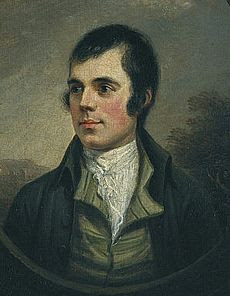 Robert Burns by Alexanfer Nasmuth
Robert Burns by Alexanfer NasmuthFirstly, we stopped off at The Robert Burns Birthplace Museum ~ talk about child-friendly. There was so much for them to do, my boys had a wonderful time, and even my teen found it interesting. Burn's life was set out in a fascinatingly refreshing way, and I learnt a lot myself ~ what a character he was! I had no idea.
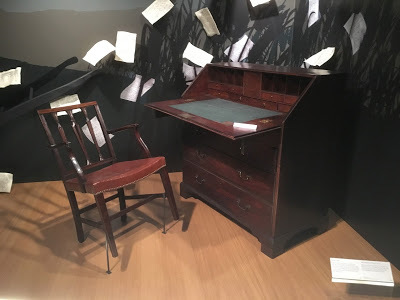
We then went on to the house in which he was born ~ it is a few minutes walk away from the museum. This tiny three-bedroom house was not only home to the family, but to their animals as well. My children didn't take to that idea to kindly, no one wanted to share their home with a cow ~ I can’t say I blame them on that one!!

The property is owned by TheNational Trust for Scotland, and as we are member's of The National Trust, it meant we got in for free...Bonus!
They have a lovely cafe at the Burn's Museum and beautiful gardens. It is well worth a visit, especially if you have children, they definitely will not be bored. I Highly Recommend you check it out sometime.
Published on October 04, 2016 00:00
October 3, 2016
Scottish History…it’s a little bit complicated #Scotland #history
It has been a little bit quiet around here in the last week and no, I didn't run out of things to say - as if that would ever happen - I was in fact on vacation. I know, what a terrible excuse. A writer is always writing...right? I was certainly inspired. But that's Scotland for you...she does that.
This is my third time visiting Scotland, and it won't be the last. Scotland has this terrible habit of getting under your skin. I have spoken to folk who have never even been there - but have this unexplainable longing in their heart to go home. To go home to a place that they have never been. To a place that only their heart seems to know. Strange...isn't it? Or maybe it isn't, perhaps there is some scientifically rational explanation to this indisputable tug towards a particular place. Or let's be romantic and say it is our ancestors calling us home.
"A Scot is a Scot even unto a hundred generations."
 Melrose Abbey ~ On the Scottish Borders
Melrose Abbey ~ On the Scottish Borders
Even if it is just my fanciful imagination, I like to think that Scotland is, shall we say, in the blood. My ancestors certainly came from there. They were an integral part of Scottish History, just as my ancestors were to English History. But as I stood at the monument at Bannockburn, I felt an almost overwhelming sense of the past got through me. Voices, shadows, hopes, fears, kind eyes, cruel ones, exhaustion and relief - no joy, just relief that it was over. A writer's paradise if you like. I can close my eyes and hear the music, and I am not the only one. The past is alive, if only you will take the time to listen, Scotland will tell you her story.
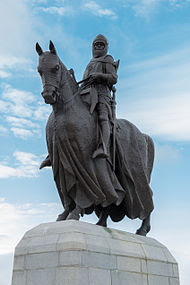
The Robert the Bruce Monument, Bannockburn ~ Stirling Today, our obsession with Scotland can be blamed on films like Braveheart or the majestic story telling of Diana Gabaldon, Outlander series. Scotland is in vogue, so to speak. And although the Scots call Braveheart "that comedy," it has romanticised their country for them. Everyone knows who William Wallace is - thanks to Braveheart. I had certainly not heard of him, until then.
 The Wallace Monument ~ Stirling
The Wallace Monument ~ Stirling
I was taking a guided tour at Hopetoun House in Edinburgh. Hopetoun House was used on location for Outlander. The tour guide said that since Outlander, they have a least one visit per day from tourists who come to the house because of the Outlander connection. He said they have a lot to thank Outlander for, and then he laughed and said, "of course, it wasn't really like that. Outlander only tells the one side of events. It wasn't the Jacobite's ( Scotland) against the might of the English Army. It was a little more complicated than that.
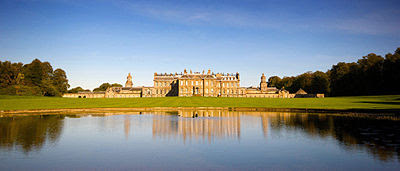 Hopetoun House ~ Edinburgh
Hopetoun House ~ Edinburgh
And that is Scottish history for you...it is a little bit complicated.
I am going to look at some of the places I visited in future posts. But for now, I'll just leave you with this...
 On the way to Hermitage Castle ~ the Scottish Borders
On the way to Hermitage Castle ~ the Scottish Borders
This is my third time visiting Scotland, and it won't be the last. Scotland has this terrible habit of getting under your skin. I have spoken to folk who have never even been there - but have this unexplainable longing in their heart to go home. To go home to a place that they have never been. To a place that only their heart seems to know. Strange...isn't it? Or maybe it isn't, perhaps there is some scientifically rational explanation to this indisputable tug towards a particular place. Or let's be romantic and say it is our ancestors calling us home.
"A Scot is a Scot even unto a hundred generations."
 Melrose Abbey ~ On the Scottish Borders
Melrose Abbey ~ On the Scottish BordersEven if it is just my fanciful imagination, I like to think that Scotland is, shall we say, in the blood. My ancestors certainly came from there. They were an integral part of Scottish History, just as my ancestors were to English History. But as I stood at the monument at Bannockburn, I felt an almost overwhelming sense of the past got through me. Voices, shadows, hopes, fears, kind eyes, cruel ones, exhaustion and relief - no joy, just relief that it was over. A writer's paradise if you like. I can close my eyes and hear the music, and I am not the only one. The past is alive, if only you will take the time to listen, Scotland will tell you her story.

The Robert the Bruce Monument, Bannockburn ~ Stirling Today, our obsession with Scotland can be blamed on films like Braveheart or the majestic story telling of Diana Gabaldon, Outlander series. Scotland is in vogue, so to speak. And although the Scots call Braveheart "that comedy," it has romanticised their country for them. Everyone knows who William Wallace is - thanks to Braveheart. I had certainly not heard of him, until then.
 The Wallace Monument ~ Stirling
The Wallace Monument ~ StirlingI was taking a guided tour at Hopetoun House in Edinburgh. Hopetoun House was used on location for Outlander. The tour guide said that since Outlander, they have a least one visit per day from tourists who come to the house because of the Outlander connection. He said they have a lot to thank Outlander for, and then he laughed and said, "of course, it wasn't really like that. Outlander only tells the one side of events. It wasn't the Jacobite's ( Scotland) against the might of the English Army. It was a little more complicated than that.
 Hopetoun House ~ Edinburgh
Hopetoun House ~ EdinburghAnd that is Scottish history for you...it is a little bit complicated.
I am going to look at some of the places I visited in future posts. But for now, I'll just leave you with this...
 On the way to Hermitage Castle ~ the Scottish Borders
On the way to Hermitage Castle ~ the Scottish Borders
Published on October 03, 2016 00:00
September 26, 2016
#bookreview ~ To Find A Viking Treasure #romance @ginaconkle
To Find a Viking Treasure(Norse Series Book 2)byGina Conkle
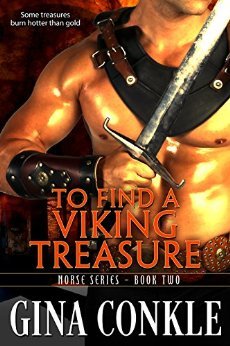 "...Conkle's eloquent writing makes every scene shine." -Publishers Weekly.
"...Conkle's eloquent writing makes every scene shine." -Publishers Weekly.Survival's in his blood
Rough-souled Brandr's ready for a new life far from Uppsala, but he can't stop thinking of a certain flame-haired thrall named Sestra who gets under his skin. Before he leaves for good, the Viking has one final task --Protect her at all costs.
Saving others is her purpose
A slave since birth, Sestra's life has been filled with hardship...until she learns of a treasure hoard. With war coming, claiming the riches will save lives, but only one Viking can help her on this journey --Brandr, the fierce silver-eyed scout.
Chasing more than silver and gold
Brandr and Sestra have shared taunts and barbs. Now they must share trust in what becomes a desperate bid to survive. Passions flare as secrets unfold, leading one to make a daring sacrifice that changes everything on their quest To Find a Viking Treasure...
***
What did I think of the story?
Everyone has a past, but not everyone has a future. Sestra fears what her future will bring, for she has just been sold to a new unknown master. She has long stopped dreaming of freedom. But she can't stop her feelings for a certain rough-souled Viking, called Brandr.
Brandr has no intention of falling in love with a flame-haired thrall, but fate throws them together.
Sestra has knowledge where a great Viking treasure horde has been buried. If she can find the treasure, then maybe she can buy her freedom. But what use is freedom if Brandr isn't there to share it with her?
I cannot put into words how much I loved this book. Conkel has brought the Viking world back to life in this beautiful, beautiful, romance.
Sestra is the most perfect of heroines. She has been a slave since birth and has never known what freedom is, and now her master want to sell her, and there is nothing she can do about it. However, despite all this, she isn't a bitter character. She is kind and compassionate, feisty when she needs to be, and can give as good as she gets, especially when it comes to Brandr.
I loved the banter between Brandr and Sestra. It made their relationship very real in the telling and believable.
I really liked Brandr. He is the perfect match for this fiery red-head and despite trying to keep his distance from Sestra, he feels compelled to protect her. And protect her he will, no matter what the cost to him.
An evocative, emotional read, set in the land of the Vikings. What could be better?
I Highly Recommend.
Links to PurchaseAmazon USAmazon UK About the author
 Gina writes Viking and Georgian romance. Her passion for castles and old places (the older and moldier the better!) means interesting family vacations. Good thing her husband and two sons share similar interests. When not visiting fascinating places, she can be found in southern Michigan delving into the latest adventures of organic gardening, occasional cooking, and serving as chief taxi driver. Find her on the web at ginaconkle.com
Gina writes Viking and Georgian romance. Her passion for castles and old places (the older and moldier the better!) means interesting family vacations. Good thing her husband and two sons share similar interests. When not visiting fascinating places, she can be found in southern Michigan delving into the latest adventures of organic gardening, occasional cooking, and serving as chief taxi driver. Find her on the web at ginaconkle.com
Published on September 26, 2016 00:00
September 22, 2016
Legend by Arthur Guiterman #Arthurian #myths #poetry
I thought I would share this fabulous poem about The Once And Future King by Arthur Guiterman (1871 -1943). Legend

Boulders huge and dales encumber
Where, in necromantic slumber
Arthur lies with all his peers
Through the long, long days of summer,
Through the long, long nights of winter,
Through the hundred, hundred years.
Gray is all the vale untrodden,
Cloud and crag are gray and hodden,
Gray the earth whence nothing grows;
Gray the hue of hills and rocks is;
Nothing red is there but foxes,
Nothing black is there but crows.
Deep the cavern: Twelvescore bowmen,
Fivescore knights with tenscore yeomen
Sleeping, hedge their sleeping lord,
Who reposes, silken-vested,
Golden-bearded, massy-chested,
Strong and silent as his sword.
Aye, the sword; what arm may guide it!
There it hangs, a horn beside it,
Near the cavern's outer bounds
Where in dreams of greenwood chases,
Clean-limbed, sprawl in fancied races
Fourteen packs of coupled hounds.
When the world is old and weary,
Loveless, lawless, mirthless, dreary,
Racked with doubt, by discord torn,
One shall come, in youth immortal,
Who shall cross the gloomy portal,
Draw the sword and blow the horn.
Broke shall be the spell; up-leaping
Hounds, fullcry, shall rouse the sleeping;
Steed shall neigh and steel shall ring;
Forth shall ride the doughty fighters,
Hate-subduers, evil-righters,
Knights and yeomen round their king
Published on September 22, 2016 00:00
September 21, 2016
Can Merton du Lac kill his brother’s demon?
The Pitchfork RebellionByMary Anne Yarde
 From the author who brought us The Du Lac Chronicles…
From the author who brought us The Du Lac Chronicles…When the devil wanted to destroy the world he would do so with fire. Alden du Lac knew this for a fact, because the devil had come to Cerniw.
Alden may have driven the man who tortured him from his lands, but he can do nothing to drive him from his dreams.
Alden has become bitter, angry and unrecognizable to those who love him. The only person whom could possible bring him back from the brink is his younger brother Merton. But even Merton is at a loss as to what to do.
As Alden seemingly wars with himself, there is a new threat to the kingdom. A threat that nobody foresaw, or could have possibly predicted…
The adventure continues in this beautiful novella.
***Book Extract ~ Chapter 2
“Can you remember what I was like when we lost Father and Mother?” Merton asked quietly. Neither of them liked speaking of that time; the pain was too great. It had been bad enough they had lost their father. Their mother had then died unexpectedly two days later. The healer had said it was from a broken heart.
“You didn’t speak for two sennights. It was very peaceful. What has this got to do with Wessex?”
“I wanted to hide. Hide myself away from the world.”
“You did hide. No one could find you for two days. You scared the life out of me.” Alden heard his own words and he saw the way Merton was looking at him. “You cannot compare the two situations. You were a child.”
“But you were the one who never stopped looking for me. You were the one who found me. You were the one who went out of your way to try and make me laugh. Even when I rebuked you, you never gave up. You sat with me when I ate, to make sure that I did. You read to me, you played with me, you took me out riding.”
“You are my brother. I wasn’t going to give up on you.” Again Alden heard what he said and he shook his head. No one could play with words like Merton. Merton could convince you the sun was blue if you gave him enough time. And the thing was, you wouldn’t realise that he had manipulated your opinion in any way. You would think that the whole concept of the sun being blue was something you had thought up by yourself. “I know what you are trying to do, Merton, and it isn’t going to work.”
Undeterred, Merton continued, “One night, not long after my two-day disappearance, I woke up in the middle of the night screaming and you…you rushed into my chamber-”
“Of course I rushed into your chamber. I thought someone was murdering you,” Alden said, remembering.
“Maybe so, but Garren didn’t come and neither did Budic and all our chambers were on the same floor. If I remember rightly, yours was the farthest away from mine.”
“Merton-”
“You calmed me down and asked what I had dreamt of. I didn’t want to tell you because I feared you would laugh at me and call me a baby, but you said that the only way to stop a dream from coming true was to tell it. So I told you and you didn’t laugh. Instead you got into bed with me and held me throughout that night and the following nights for the next month. Let me return the favour and help you now.”
“You are not sleeping with me,” Alden instantly retorted.
ONLY 0.99 c/pLinks to PurchaseAmazon USAmazon UK
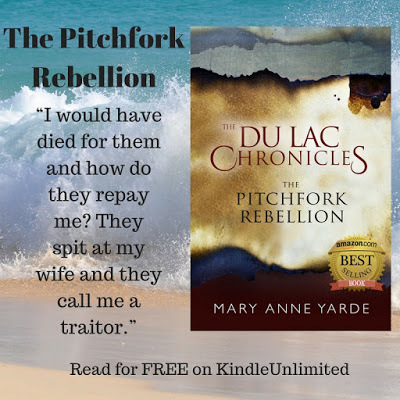
Published on September 21, 2016 00:00
September 19, 2016
#bookreview ~ Worth Fighting For #histfic
It was my very great pleasure to receive an ARC copy of Mary-Anne O'Connor's latest book.
Worth Fighting For
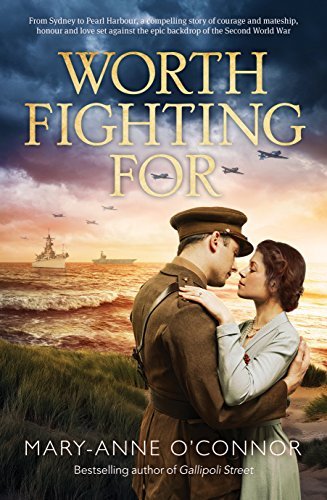
From Darwin to Pearl Harbour, Sydney to Papua New Guinea, a compelling story of courage, honour and a great love set against the epic backdrop of the Second World War.
Eighteen-year-old Junie Wallace is a smart girl and, with her two brothers away at war and her third brother just killed in action, she knows there is only one way to save the family farm for her grieving parents. Unfortunately, that solution involves marrying the unscrupulous Ernest, and breaking the heart of the young drover she loves, Michael.
But the war is looming ever closer, and when Pearl Harbour brings the threat of Japanese aggression to Australian shores, the fates of many becomes inextricably interwoven.
From the explosive battles of the Pacific campaign to the desperate fighting in the Papuan New Guinea rainforest; the dancehall gaiety of Sydney’s Trocadero to the terror of the Darwin bombings, this epic family saga brings home the importance of mateship and of fighting for what you believe in, even when impossible odds seem stacked against you, even when all seems lost…
Worth Fighting For is a resounding testament to the enduring force of love: a reminder of what can be achieved if you draw on your reserves of courage and listen to the truth in your heart.
Links to PurchaseAmazon US
Amazon UKWhat did I think of the book?
Junie Wallace is engaged to be married. She is to marry the man who has rescued her family from financial disaster. This should be a happy occasion. A win, win situation for everyone. Alas her heart belongs to another, a young drover called Michael. Michael has stolen her heart, but will she ever be free to give him hers?
Worth Fighting For is an evocative, emotional read about the courage of one young woman, who puts her family above her own happiness.
Set in the backdrop of WW2, Worth Fighting For is rich in historical detail. From the horrors of Pearl Harbor to the fierce fighting in Papua New Guinea's rainforest, this book describes the horrors of war in explicit detail. It was very real in the telling and at times, I found myself reaching for the Kleenex as characters I came to care about faced life and death situations.
Junie is a well-rounded and believable character, trapped in an impossible situation. I felt her heartache and her despair, and I rejoiced with her triumphs.
O'Conner does not shy away from the treatment of the indigenous tribes in Australia at the time, and I thought she approached this delicate subject with compassion and humanity.
Worth Fighting For is a well-researched and compelling read. I read the book in one sitting. I simply could not put it down. With beautiful prose and an enthralling storyline, I have no hesitation in recommending this book.
I Highly Recommend.
Published on September 19, 2016 00:00
#bookreview ~ Worth Figting For #histfic
It was my very great pleasure to receive an ARC copy of Mary-Anne O'Connor's latest book.
Worth Fighting For
 From Darwin to Pearl Harbour, Sydney to Papua New Guinea, a compelling story of courage, honour and a great love set against the epic backdrop of the Second World War.
From Darwin to Pearl Harbour, Sydney to Papua New Guinea, a compelling story of courage, honour and a great love set against the epic backdrop of the Second World War.Eighteen-year-old Junie Wallace is a smart girl and, with her two brothers away at war and her third brother just killed in action, she knows there is only one way to save the family farm for her grieving parents. Unfortunately, that solution involves marrying the unscrupulous Ernest, and breaking the heart of the young drover she loves, Michael.
But the war is looming ever closer, and when Pearl Harbour brings the threat of Japanese aggression to Australian shores, the fates of many becomes inextricably interwoven.
From the explosive battles of the Pacific campaign to the desperate fighting in the Papuan New Guinea rainforest; the dancehall gaiety of Sydney’s Trocadero to the terror of the Darwin bombings, this epic family saga brings home the importance of mateship and of fighting for what you believe in, even when impossible odds seem stacked against you, even when all seems lost…
Worth Fighting For is a resounding testament to the enduring force of love: a reminder of what can be achieved if you draw on your reserves of courage and listen to the truth in your heart.
Links to PurchaseAmazon US
Amazon UK What did I think of the book?
Junie Wallace is engaged to be married. She is to marry the man who has rescued her family from financial disaster. This should be a happy occasion. A win, win situation for everyone. Alas her heart belongs to another, a young drover called Michael. Michael has stolen her heart, but will she ever be free to give him hers?
Worth Fighting For is an evocative, emotional read about the courage of one young woman, who puts her family above her own happiness.
Set in the backdrop of WW2, Worth Fighting For is rich in historical detail. From the horrors of Pearl Harbor to the fierce fighting in Papua New Guinea's rainforest, this book describes the horrors of war in explicit detail. It was very real in the telling and at times, I found myself reaching for the Kleenex as characters I came to care about faced life and death situations.
Junie is a well-rounded and believable character, trapped in an impossible situation. I felt her heartache and her despair, and I rejoiced with her triumphs.
O'Conner does not shy away from the treatment of the indigenous tribes in Australia at the time, and I thought she approached this delicate subject with compassion and humanity.
Worth Fighting For is a well-researched and compelling read. I read the book in one sitting. I simply could not put it down. With beautiful prose and an enthralling storyline, I have no hesitation in recommending this book.
I Highly Recommend.
Published on September 19, 2016 00:00
September 15, 2016
Robin Hood and the dishonourable Prince John
“Bell, book, and candle shall not drive me back,
When gold and silver becks me to come on.”
King John (3.3.12) by William Shakespeare
Last time, on my hunt for Robin Hood, I took a look at King Richard and his role in the legend. Today I want to look at his brother, the infamous Prince John.
I have always taken quite an interest in the life and times of King John. I am, dare I admit it, a direct descendant of his. Yes, you heard, I have a notoriously bad king as a Grandfather ~ sounds about right!
King John is often portrayed as this womanising coward, who was intent on bringing down his brother. Can you remember Disney's Robin Hood ~ Prince John is a lion without a mane who sucks his thumb when things go wrong. That portray kind of rattles actually. Now, don't get me wrong, I am not his champion, far from it. He wasn't the greatest of kings, but there was more to him than meets the eye. I will concur, however, that he is the perfect antagonist for our Robin Hood.
I thought as I did with Richard in the last post, I would give you an abbreviated version of John's life. Out of all the Kings of England, I think John is one of the most fascinating figures to research.
But, as with all things, to understand where John ended up, it is important to start where he began.
John was the youngest child of Henry II and Eleanor of Aquitaine. He was born on the 24th December 1166. No one ever thought he would become King, at least of all his father who nicknamed him John Lackland ~ which simply put, means he had no lands to inherit. Henry wanted to do something about that. He didn't want his youngest son to be left with nothing. If only Henry had possessed the gift of hindsight, then maybe history would have gone down an altogether different path.
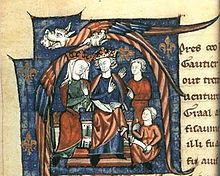
Henry II and Eleanor of Aquitaine holding court.
Henry II is a complicated character to get my head around. He appears, on one hand, to be a devoted father who only wants the best for his children. Unfortunately, his wife, who seems to have great influence over their sons, hinders him at every opportunity. It was her influence that set off a disastrous chain of events. However, Eleanor cannot be held solely responsible, Henry chooses to do something so irresponsibly stupid that I cannot even believe I am writing it down.
Most of us understand how Kingship works. There are two ways to become a king. You either inherit the title, or you take over a kingdom, dispose of the king and place yourself on the throne. What you don't do, is share the throne with your son. You do not declare to your kingdom that your son is now also the King of England. Two roosters ruling the roost ~ what a recipe for disaster.
Although named King, Henry the Younger King had no powers. He was King in name only, and his resentment festered. What was the point in being King, if he had to look constantly to his father for permission to do anything? It was an empty crown with a hollow promise.
And what was worse, Henry the Younger King had to watch while his father bestowed praise on his youngest and unworthy brother, John. John was the golden boy. The one who could do no wrong. Jealousy darkened Henry the Younger King’s heart. Was there ever a more twisted and bitter family as theirs?
Henry II wanted to secure lands for John, as he had done with his other sons. There is nothing wrong with that, you may think. But by doing so, he would tear his family apart. Not only would they rebel against him, but they would also fight amongst themselves. They knew not what family loyalty was. It was every man for himself.
Encouraged by their mother, the brother's revolted against their father in 1173. The reason why? John had been favoured and it wasn't fair. Their father was giving lands to John that Henry the Younger King saw as his inheritance and worse still, his father had not consulted him. Was he a King or not? How dare he.
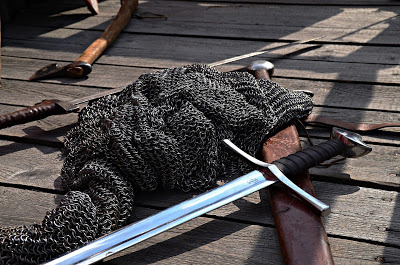
The rebellion was short-lived and quickly suppressed. A peace treaty was drawn up. Henry II was more than generous to his traitorous sons. However, that was nothing in comparison to how he awarded his eight-year-old son, John, who had remained loyal to him throughout.
But it didn't end there, not for this war hungry family. News reached the King that his eldest son, Henry the Younger King was a war with his brother, Richard. Henry sided with Richard and by the end of the war, Henry the Young King was dead. Henry II immediately drew up plans to make Richard heir to the throne. His other son, Geoffrey would retain Brittany, but his youngest son, John would become the Duke of Aquitaine, a title that Richard currently held. Richard was enraged. He would not hand over his lands to his brother, and once more Henry II prepared himself for war. This war ended in stalemate.
Henry II then had this rather brilliant idea of making John the King of Ireland. But John's first visit to Ireland was nothing short of a fiasco, and he came home full of anger and resentment, blaming others for his shortcomings.
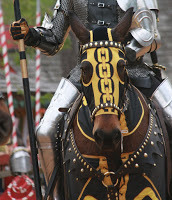 Meanwhile, John's brother Geoffrey died. Geoffrey left a son, Arthur, and a daughter. Richard was keen to go on Crusade, but he feared that if his father were to die, while he was away, then John would be appointed King. It was time to put an end to this matter once and for all. Richard took up arms and with the support of his allies he once again warred with his father.
Meanwhile, John's brother Geoffrey died. Geoffrey left a son, Arthur, and a daughter. Richard was keen to go on Crusade, but he feared that if his father were to die, while he was away, then John would be appointed King. It was time to put an end to this matter once and for all. Richard took up arms and with the support of his allies he once again warred with his father. John, stayed loyal to his father until he realised that this time, his father was on the losing side. John changed sides. It is said that after Henry's defeat in battle, he learnt of John's treachery, and it broke his heart. He died two days after.
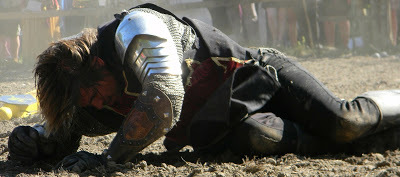
Richard was crowned King, and then he promptly left for the Crusades. He left his kingdom in what he thought was capable hands. He made William Longchamp his Chancellor ~ a fatal error for the man was unpopular, and it gave John the excuse to set up an alternative court. John had an eye on his brother's throne, and he wanted to be ready to step in if Richard were to have an unfortunate accident in the Holy Lands. John was canny; he remained faithful to Richard. He gave Richard no reason to doubt his loyalty.
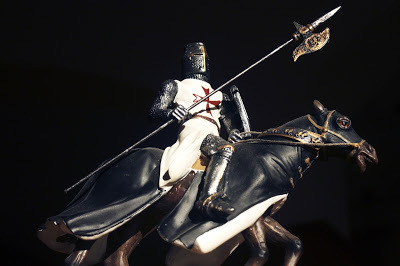
And then the unthinkable happened. The Lionheart died.
Which left two possible claimants to the throne.
John and his nephew, Arthur.
It would take a war to decide who the rightful heir was. It would take more than one post to tell you all about what happened next, but the long and the short of it is that John was victorious over Arthur, and he took not only Arthur but many of Arthur's knight's prisoners. It is, I think, what happened next, that defined John's reign.
John was nothing like his father. He had witnessed first hand what happened when you forgave your enemies. He was not going to make the same mistakes as his father. Despite the captured knights being kin, his treatment of them was appalling. Twenty-Two of them died while in his care. But then John did something even more unforgivable.
"John had captured Arthur and kept him alive in prison for some time in the castle of Rouen ... when John was drunk he slew Arthur with his own hand and tying a heavy stone to the body cast it into the Seine." The Annals of Margam Abbey
This was his nephew. His brother's son. But John had other things to worry about. Philippe II was gaining ground. John was going to lose Normandy if he wasn't careful. And lose it he did.
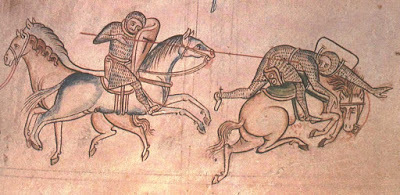 William the Marshal, one of John's most senior military leaders, by Matthew Paris
William the Marshal, one of John's most senior military leaders, by Matthew ParisWhat John needed was money. If only he had more money, then nothing would stop him from taking Normandy back. However, England was already impoverished thanks to Richard's campaign to the Holy Lands and subsequent ransom. John became obsessed with thinking up new ways with which to fill his treasury.
Let's take a step back, and think again of Robin Hood.
"Robin…stole from the rich,To give to the poor."
But John was also robbing from the rich, but legally and in the form of taxes. He started to sell Sherriff appointments. And these Sheriffs had to make their money back somehow ~ they increased the cost of fines and penalties.
No one was excluded from John's taxes, and John made sure that everybody paid. The nobles had their income taxed for the first time ~ which saw a staggering £60,000 go into the treasury. Import and export duties were to be paid directly to the crown. And if the Baron's refused to pay, well then, John would just take their land as payment.
John's reign was far from peaceful, not only did he want to win back Normandy, but he also had to deal with Scottish aggression, Irish and Welsh. John then fell out with the church, with resulted in his excommunication.
It is no surprise that the Barons revolted. John agreed to meet the rebels at Runnymede on 15th June 1215. John was presented with a charter ~ which would later become known as The Magna Carta ~ The Great Charter. The Baron's wanted political reform. They wanted assurances. John agreed to the terms, although both sides knew that John didn't mean it, and he would appeal it at the first given opportunity.
The Barons had no choice, but to arm themselves and go to war against their king. John's campaign started well, but it rapidly went downhill when the Barons, invited the French Prince, Louis, to lead them. John wasn't going to give up without a fight, but then John contracted dysentery, which unfortunately proved fatal. John died in 1216.
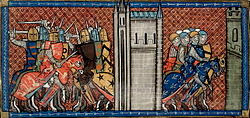
King John of England in battle with the Francs (left), Prince Louis VIII of France on the march (right). (British Library, Royal 16 G VI f. 385)I can see why Robin Hood would be connected with King John; it makes a sort of twisted sense. John did, after all, sell Sheriff appointments, and so this makes the idea of an "evil" Sheriff somehow more believable. And I like the idea that Robin was stealing the tax money and giving it back to the poor. Such antics would have certainly not gone unnoticed by the king. But there is nothing on parchment that suggests such a thing occurring. I don't see John riding up to Sherwood to reprimand the Sheriff personally for not doing more to stop this outlaw. Surely he would have just replaced the sheriff?! Nevertheless, it is fascinating stuff...isn't it?!
Published on September 15, 2016 00:00
September 13, 2016
Robin Hood & King Richard ~ the strangest alliance in history.
Do not miss this fight of the millennia…
Robin Hood and King Richard v. Prince John and the Sherriff of Nottingham.
This is a tag-team fight like no other and not to be missed. Come, Ladies and Gentlemen, place your bets and let the battle begin.
I thought researching Arthur, and his Knights was hard. But I will admit, hands down, that Robin Hood is far more elusive. Let's put what I was blogging about the last time into context.
The most likely contender for the real Robin Hood was an apparently wealthy fugitive who was running around in 1225.
Legend states that Robin was the enemy of the cruel and vile Sheriff of Nottingham and the spineless and arrogant, Prince John. But, Robin was a friend to the noble and kind King Richard. Sound familiar?
I think I need to explore these three men in more detail to try and get a handle on the time, and how they came to fit into the Robin Hood tale. I am going to start by having a look at King Richard's life. This will be the abbreviated version, otherwise it would take several posts, and I don't want to bore you with the detail.
The Life of King Richard the Lionheart
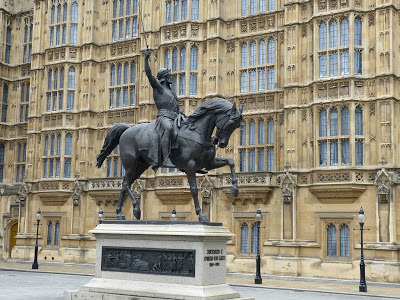 Richard Coeur de Lion, Carlo Marochetti's statue of Richard I outside the Palace of Westminster, London
Richard Coeur de Lion, Carlo Marochetti's statue of Richard I outside the Palace of Westminster, London 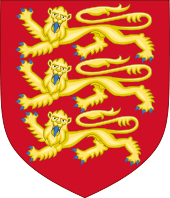 Richard the Lionheart, son of Henry II, was born in Oxford and grew up in England. Richard never learnt the language of his birth and the kingdom that he would one-day rule. He could only speak French. By the age of 16 he not only had his own army, but he was also a formidable warrior.
Richard the Lionheart, son of Henry II, was born in Oxford and grew up in England. Richard never learnt the language of his birth and the kingdom that he would one-day rule. He could only speak French. By the age of 16 he not only had his own army, but he was also a formidable warrior.In 1173, Richard and his brothers (excluding John) revolted against their father. The rebellion failed, and Richard begged for his father's forgiveness. This wasn't your average teenage rebellion. Richard wasn't being told off for staying out late and partying with his friends. He and his brother’s had raised arms against their sovereign king. Richard was lucky he didn't lose his head. But Henry II was the forgiving kind, but unsurprisingly, he would never trust his son(s) again. Can you imagine what Sunday lunch at the palace must have been like? Talk about cutting the tension with a knife!
Richard is portrayed as this mighty hero. But in the next few years, those who lived under Richard’s jurisdiction would tell quite a different tale if they were still alive to tell it. Richard was ruthless and cruel. There were organised uprisings against him because of his brutality. But he returned fire with fire and stamped out the rebellion viciously. Sean Connery, he was not.
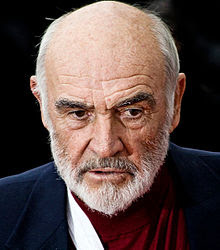 Sean Connery played King Richard in the 1991 movie Robin Hood, Prince of Theives.
Sean Connery played King Richard in the 1991 movie Robin Hood, Prince of Theives.Richard revolted against his father again. In 1189 Richard and his allies defeated Henry's army at Ballans. Two days later Henry died, and Richard became king.
But living under Richard's rule wasn't the picnic the legends and Hollywood would have you believe. His reign didn't get off to the best of starts. He banned Jews and women from his investiture. Some thought this gave them free rein to attack the Jewish community and a rumour came about that Richard wanted the mass execution of all the Jews. The Jews were massacred. It was a blood bath. Richard, it is said, was enraged. He wanted to go Crusading, but how could he with such unrest. He ordered the execution of those responsible and distributed a Royal Writ, which stated that the Jews were to be left alone. They were - dare we say it - his property. But things didn't get any better for the Jews, for the law was very loosely enforced, perhaps because the king had merely said the words for show.
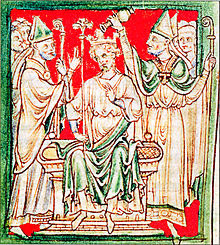 Richard I being anointed during his coronation in Westminster Abbey, from a 13th-century chronicle
Richard I being anointed during his coronation in Westminster Abbey, from a 13th-century chronicle All Richard was interested in was making his name as a Crusader. He had been to the Holy Land’s once and he wanted to go back. He needed to raise money to go to war, and he would find that money, even if it meant bringing England to her knees.
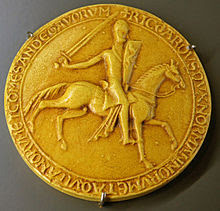
King Richard I's Great Seal of 1189
It was rumoured that Richard once said…
"I would have sold London if I could find a buyer."
That is how much he valued the land in which he ruled. England was little better than a personal bank for this ambitious king.
Richard had delayed long enough. The Holy Land's were calling, it was time to say goodbye to England and go to war.
In 1192 came the horrifying news that Richard had been captured. Along with this news came a ransom note from Henry VI, the Holy Roman Emperor. For Richards release, the Emperor demanded 150,000 marks ~ an absolute fortune. Richard had already emptied the treasury to go to war. But this was the king, the money would be found, even if they had to strip every church in the kingdom of its gold. They raised the taxes. If the poor starved then so be it. They would find the money. Ironically Richard's brother John, along with King Philip of France offered 80,000 marks to the Emperor to keep Richard imprisoned until Michaelmas 1194! What a family. What a King. The Emperor refused John’s very kind offer. The money was found, and the ransom was paid. Richard was released.
King Philippe of France sent John this message...
"Look to yourself; the devil is loose."
Indeed, Richard’s people had ensured his release, and now he was bound to seek revenge against his brother and those who had stood against him. John must have been quaking in his boots. But, Richard forgave John and named John heir to the throne despite his nephew, Arthur, being next in line.
What is it with this family? They seem to do the complete opposite to what you think they will do. How the Plantagenet’s ( or the Angevin ~ I thought I would get that in before someone complained) stayed in power for so long really is a mystery to me!
Richard, not content to go home and be a king, decided that he would recapture Normandy ~ because there was the money to do that?! Just saying!
I don’t think Richard care two hoots about his people. He lived and breathed war. He was like an addict. He needed a fix. He couldn't live without it.
 Richard was shot by an arrow in 1199 when he besieged the virtually unarmed castle of Châlus-Chabrol. So arrogant was he, that he didn't bother wearing any armour while he strode around the perimeter. The man whose arrows found it's mark was not a knight, but a mere boy seeking revenge for the death of his father and brothers. The boy was brought before Richard. But instead of ordering his execution Richard forgave him and sent him on his way with 100 shillings.
Richard was shot by an arrow in 1199 when he besieged the virtually unarmed castle of Châlus-Chabrol. So arrogant was he, that he didn't bother wearing any armour while he strode around the perimeter. The man whose arrows found it's mark was not a knight, but a mere boy seeking revenge for the death of his father and brothers. The boy was brought before Richard. But instead of ordering his execution Richard forgave him and sent him on his way with 100 shillings.Unfortunately for Richard, his wound became gangrenous. Knowing he was to die, he sent for his mother and set about putting his affairs in order.
The Lionheart died on 6th April 1199.
The boy, who had caused the fatal wound, was flayed alive and then hung. So much for Richard's words of forgiveness.
The King is dead. Long live the King.
King Richard the Lionheart was not a champion of the people. He spent barely six months in England during his reign. Instead, he was intent on seeking war and glory and wealth. Richard's association with Robin Hood doesn't make any sense. Why would Richard champion an outlaw? Richard was brutal to those who rebelled against his crown. You cannot steal from the rich and give to the poor, and expect the King to be all right with this? Because, lets face it, Richard was the biggest thief of them all. Good people died to fund his foreign wars. He quite literally took the skin off England’s back. And when John came to inherit, he found the treasury empty. And also the dates are wrong. Our Robin Hood was making a name for himself in 1225. King Richard had been dead for over 20 years by then. Something is not right there...is it?
Published on September 13, 2016 00:00
The Coffee Pot Book Club
The Coffee Pot Book Club (formally Myths, Legends, Books, and Coffee Pots) was founded in 2015. Our goal was to create a platform that would help Historical Fiction, Historical Romance and Historical
The Coffee Pot Book Club (formally Myths, Legends, Books, and Coffee Pots) was founded in 2015. Our goal was to create a platform that would help Historical Fiction, Historical Romance and Historical Fantasy authors promote their books and find that sometimes elusive audience. The Coffee Pot Book Club soon became the place for readers to meet new authors (both traditionally published and independently) and discover their fabulous books.
...more
...more
- Mary Anne Yarde's profile
- 159 followers



